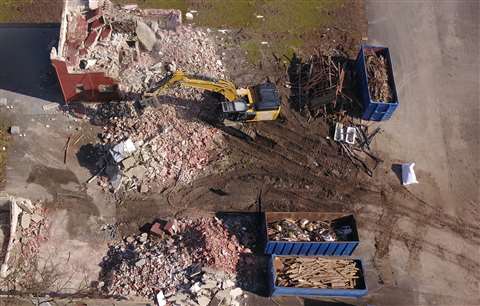European construction not yet ready for circular economy, study shows
28 February 2023
The construction industry still isn’t ready for the transformation to a circular economy as mandated by the European Union.
 A study has warned that the European construction industry isn’t aligned with the EU’s plans for a circular economy (Image: Adobe Stock)
A study has warned that the European construction industry isn’t aligned with the EU’s plans for a circular economy (Image: Adobe Stock)
That’s according to a recent study by the German Sustainable Building Council (DGNB).
Of the 38 new building and renovation projects it studied, it couldn’t find one that could be considered as being aligned to the EU’s classification system.
There were particular problems around reused and recycled materials, according to the study.
The EU launched a taxonomy in 2020, which serves as a classification system for sustainable investments aimed at accelerating carbon-neutral transformation in Europe.
None of the 38 construction projects in the study met the materials quota, which stipulated that at least 15% of introduced building materials should be reused, 15% recycled, and 20% either renewable, reused or recycled.
The study blamed this on a lack of suitable materials, as well as on shortcomings in information and data on the circular economy.
DNGB CEO Dr Christine Lemaitre said, “The findings were quite a revelation. If you go to lectures and meetings or follow the media, everybody’s talking about circular building, so you get the impression the topic’s now reached industry.
“But according to this study, it’s not yet got to that point in reality – in the buildings around us.”
Of the 38 projects in the study, 35 were new buildings and three were renovations. More than half of all new buildings met less than 50% of the requirements.
The projects did perform better when it came to demonstrating the future value retention of buildings or their ability to preserve the value of building materials. Projects could show that buildings were designed to be adaptable or allowed materials to be reclaimed.
But the DGNB did identify what it called a “major hurdle” concerning identifying suitable methods and working out documentation requirements. Projects only succeeded with this if they were undergoing sustainability certification in parallel and were able to draw on the specifications this offered.
Recommendations to the EU
Researchers involved in the study have already made recommendations to the EU Commission.
They called for the introduction of a building material passport to plug information and data gaps. It said that a passport could capture all information on the recyclability of materials and offer information on maintenance and different ways to remove or recycle materials in the future.
And they recommended that the EU taxonomy is brought into harmony with systems that currently evaluate the sustainability of a building, such as the DGNB certification system.
One overarching recommendation they made was that the EU brings the ambitions central to environmental targets into alignment.
The EU classification system includes six environmental objectives. In order for a company or developer to show that buildings comply with the EU taxonomy, they have to make a significant contribution to one environmental goal and meet “do no significant harm” (DNSH) requirements for the other five goals.
Until now, companies have been able to choose between two environmental objectives: climate change mitigation and climate change adaptation. Lemaitre said, “If the criteria stay the way they are now, nobody in industry will choose to move to a circular economy because in comparative terms, the climate targets require less effort and lower outlays. To remain ambitious about the circular economy goal, we recommend the development and sharing of a roadmap so the market can prepare for future requirements.”
Lack of incentive to renovate
Meanwhile, Lemaitre criticised the taxonomy for a lack of incentive to renovate existing buildings and use resources sparingly. She said, “The first thing that should come to mind when you’re thinking about the circular economy is preserving existing buildings, not erecting new buildings that could end up being taken apart many years from now.
“But also, currently the criteria could very well encourage wasteful behaviour if you can use additional renewable resources to meet the material quota. Instead, a central element should be sufficiency – as a positive design principle For example, it could be stipulated that before every new building is erected, you first need an eco-sufficiency assessment.”
STAY CONNECTED



Receive the information you need when you need it through our world-leading magazines, newsletters and daily briefings.
CONNECT WITH THE TEAM








